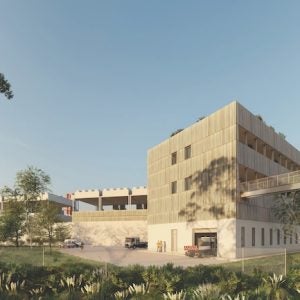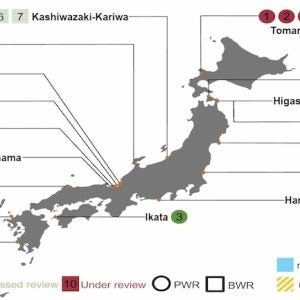
Above: Hydrogen-fuelled gas turbine cogen demonstration facility, Kobe City
The key enabling technology is a new combustor concept developed by Kawasaki, applying its “micro-mix” combustion principle.
The tests have been carried out as part of Japan’s “Technology Development Project for Building a Hydrogen-based Society”.
Further technology verification tests, with the supply of electricity and heat generated by the hydrogen-fuelled gas turbine cogeneration system (1100 kWe/2800 kWt) to nearby facilities in Kobe City’s Port Island, are planned to start this autumn.
NEDO, Kawasaki and Obayashi conducted a previous demonstration of 100% hydrogen-fuelled gas turbine based cogeneration in 2017/18, working in co-operation with Kobe City and Kansai Electric Power Co. But for these earlier tests the gas turbine combustors were of the diffusion (premix) type rather than DLN, with water injection to suppress NOx generation due to local high temperature areas in the combustion zone.
This trial was also believed to constitute a world first as “for the first time worldwide, both electricity and heat were supplied from a 100% hydrogen-fuelled cogeneration system”.
Kawasaki has been developing 100% hydrogen-fuelled DLN gas turbine combustion technology since FY 2019. In the latest verification tests the focus has been on improving electrical efficiency and reducing NOx emissions with DLN technology. The water injection required with diffusion burners reduces electrical efficiency due to evaporation of water spray in the hot combustion gas. DLN technology improves efficiency and lowers NOx but when used with hydrogen, high combustion speeds can result in flashback.
Kawasaki’s micro-mix combustion technology, which employs “ultra-small hydrogen-fueled flames” in the gas turbine combustor, aims to address the issue of achieving stable hydrogen combustion as well as low NOx.

Above: Gas turbine (left) with DLN burner employing Kawasaki’s “micro-mix” combustion technology
As gas turbine DLN combustor hydrogen trials continue, it is also planned to start parallel verification tests this autumn at the Kobe City facility on an integrated energy management system for the hydrogen fuel and the heat and electricity supplied to local community facilities.
In addition, Obayashi is pursuing research into a system capable of effectively leveraging the cold generated by the liquefied hydrogen at –253°C (1 atm). An evaporator is used to revert the liquefied hydrogen, needed as fuel for the gas turbine, back into gaseous form, but “currently the cold from the evaporator is not being put to any meaningful use.”
Furthermore, during the summer and other times of the year when outside air temperatures are high, increases in gas turbine intake-air temperatures lead to reduced electric output, and disparities with outside air temperatures cause frosting on the evaporator used for liquefied hydrogen, which necessitates power plant stoppages in order to remove the frost. Obayashi’s research aims to harness the cold resulting from gasification of liquefied hydrogen in order to lower the gas turbine intake-air temperature, thus increasing power output and efficiency in the hot summer months when demand for electric power is high.

Above: Structure of a gas turbine intake-air system that utilises cooling provided by liquefied hydrogen
Obayashi researchers also hope to utilise an intermediate thermal medium (such as propane gas) in order to remove cold from the liquefied hydrogen and prevent evaporator frosting, thus enabling continued, uninterrupted system operation.
If this system is fully developed for practical applications in the future, it will be possible to prevent wasting of cold provided by the liquefied hydrogen and achieve higher efficiency for the energy management system overall.






